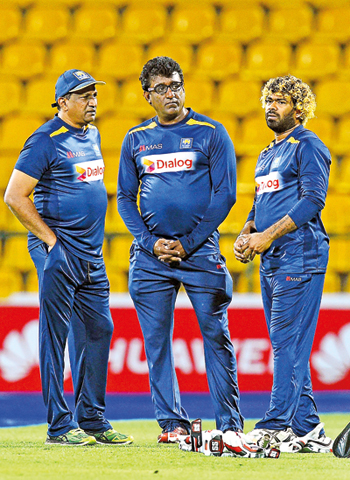The Pallekele Triple Treat

The Three Musketeers - Selector cum Manager Ashantha de Mel (L), Interim Coach Rumesh Ratnayake (C) and T20 skipper Lasith Malinga discussing today's game plan - Pic courtesy SLC
The evidence is not conclusive, but Twenty20 cricket against New Zealand doesn’t seem to be the Sri Lankans’ ‘Cup of Tea’. Strange as it may seem for a country that produced a Master Blaster who revolutionised the shortened form of the game. Two games, in particular, confirm my contention.
Go back to Auckland in January 2019. The Sri Lankans were defeated by the home team by 35 runs. Not an earth-shattering loss, but a significant one nevertheless. The Kiwis, 65-5 at one stage, recovered to total 179-7. Doug Bracewell (44 off 26) and Scott Kuggerlijn (35 off 15, with four sixes), all-rounders both, made light of early problems as they scattered an attack that had Malinga (2-24) and Kasun Rajitha (3-44).
The visiting Sri Lankans spurned 19 deliveries as they made 144 in 16.5 overs. The now-discarded Thisara Perera (not such a surprise!) top scored with a 24-ball 43, that contained two fours, and three sixes. Kusal Janith (23), Kusal Mendis (17) and Niroshan Dickwella (18) barely showed up to be counted. The express pace of Lockie Ferguson (3-21) and the enticing leg spin of Ish Sodhi (3-30) undid them.
Though disappointing, this was as nothing compared to the nine wicket-thrashing handed out by New Zealand in the T20 game of 2016, also at Auckland. Angelo Mathews, with an unbeaten 81 off 49 balls, played an eye-catching innings. TM Dilshan (28 off 26) was next best. Grant Elliot (probably, a better batsman than a bowler) was top of the pops with 4-22. Tim Southee and Adam Milne, with two apiece, kept the Sri Lankans down to 142-8.
Then followed a brutal massacre as Martin Guptill, Colin Munro and Kane Williamson feasted on some ineffective bowling, as 6.4 overs leaked 89 to the openers. Guptill scored 63 off 25 balls, with six fours and five sixes. Munro made an unbeaten 50 off 14 balls. He had seven hits over the ropes. Williamson applied the finishing touches with an unhurried 32 not out off 21 balls. These three batsmen really exposed the inadequacies of the attack as they contributed to a victory that was achieved with 10 overs to spare.
The self-same Guptill will open once more when the T20 series unwinds at Pallekele today. The good news for Malinga and his bowlers is that the tall, powerful striker is strangely out of sorts following a generally dismal World Cup.
Left-hander Colin Munro is another proven performer. In Ross Taylor’s case, there is no need to gild the lily. Colin de Grandhomme, after his blitzkrieg 83 at the P. Sara Oval, must have induced a bit of fear in the Sri Lankan camp. Scott Kuggerlijn and wicketkeeper Tim Seiffert are two others who put bat to ball with a vengeance.
The track at Pallekele will almost certainly make the pace of Ferguson more manageable. Skipper Tim Southee is an experienced, canny seamer who can make it count. De Grandhomme is a line and length bowler who is difficult to get away. New Zealand is well-stocked in the spin department having the likes of Santner, Sodhi and Todd Astle.
The much talked about Avishka Fernando has further opportunities to give local spectators glimpses of his talent. The two Kusals (enigmas, both) have got to strike it rich. Dickwella, noticeably, restrained himself upto a point and proved successful. Long may that continue! Shehan Jayasuriya has been around for some time now and should produce runs in sufficient quantity to make the transition from overage to good.
No doubt skipper Malinga’s overs will elicit watchfulness from the Kiwi batters. He is still capable of a sudden strike. Lakshan Sandaken can go for plenty, but can, by the same token, spring a surprise. He’s quite lively on the field, too. Wanindu Hasaranga provides useful leg-spin and fields very well. Dasun Shanaka can clear the ropes, but he cannot be satisfied with cameos.
Summarising, New Zealand is certainly the more experienced team and that counts in tight, crunch situations. The Sri Lankans are bristling with youth, and talent, and if it all comes together, well, who knows!


